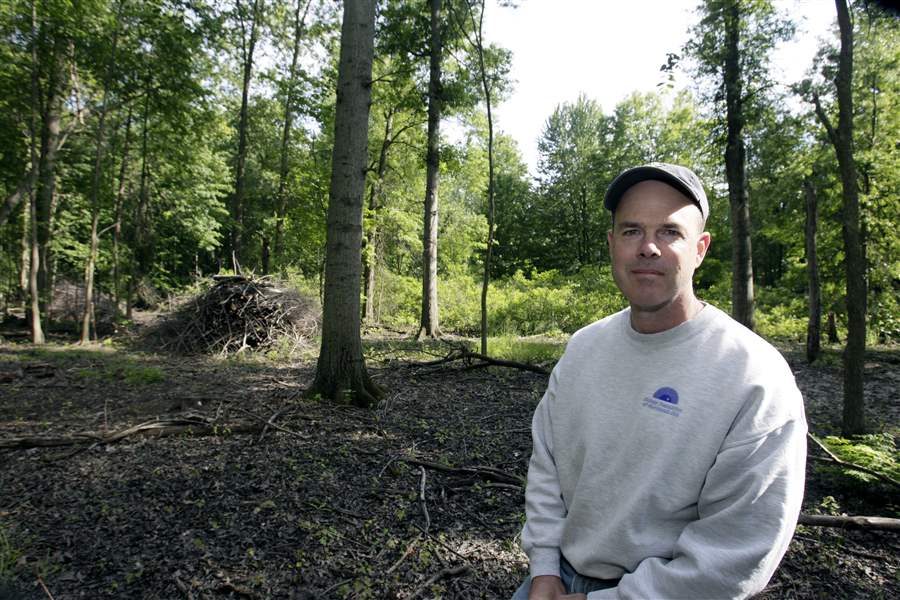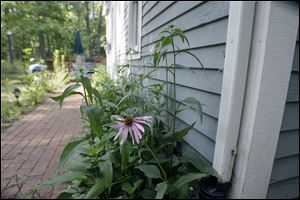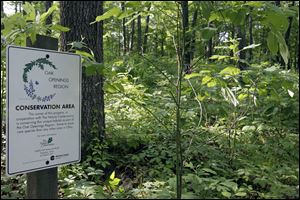
Jon Cross: committing his property to native plants
6/9/2012
Jon Cross is restoring eight acres to native Oak Openings species of plants at his home in Whitehouse.
The Blade/Jetta Fraser
Buy This Image

Jon Cross is restoring eight acres to native Oak Openings species of plants at his home in Whitehouse.
Name: Jon Cross, computer management, living in Whitehouse.
Garden specs: Eight acres, 1,320-by-265-square feet. My "garden" is the entire property and I'm in the process of restoring it back to its native Oak Openings state. It is part of the rare and endangered Oak Openings Region, most of which has been lost to development, water drainage, and intrusion by invasive and non-native species. The goal is to restore the land to its pre-European state by removing the non-native and invasive plants. This allows the natives to thrive and encourages wildlife to return.

Purple conflower along the side of the house. Jon Cross is restoring eight acres to native Oak Openings species of plants at his home in Whitehouse, Ohio.
When did you start gardening? In 2006, I was inspired by a book published by the Nature Conservancy called Living in the Oak Openings, A Homeowner's Guide to one of the World's Last Great Places. Our home is located near the Oak Openings Metropark, but prior to reading the book I didn't know we were in this region. The book helped me realize I could protect a small part of this unique habitat. The book states an estimated one third of all rare-plant species in Ohio grow in the Oak Openings Region.
What do you grow? Besides very large mosquitoes, I grow plants native to the area including trees (black oak, white, oak, sassafras, black cherry, black tupelo, witch hazel, and others), native sedge grasses, rare buttonbush, and various ferns and native wildflowers. I've planted some of these but the majority has come back on their own due to the deliberate removal of non-natives.
Favorite plant: Indian Cucumber Root. It's very rare here and grows abundantly about 50 feet from the front door.
Gardening tip: Don't be afraid of the unconventional. Habitat restoration is foreign to most people since we don't see pictures of it in Better Homes and Gardens, but the rewards are amazing.
Hours spent gardening: It varies based on time of year but averages maybe two or three per week. A lot more time is spent when I'm removing non-native species.

Along the driveway, notification that this is an Oak Openings conservation area.
Annual expense: $100 or less.
Challenges: Convincing my wife that restoration is the right thing to do. To the untrained eye, native plants can look like weeds. This project involves removing what most people think of as "the woods" (the "weeds" that need to be removed) in order to encourage native species to flourish. Sounds of chain saws and smoke from a controlled burn are not always easy to hear or see, but they're required to clear the land.
There's also the physical challenge of clearing all the overgrown brush from this large "garden." A restoration requires deliberate action instead of just letting nature take its course (which would only apply if nature wasn't disturbed in the first place by the introduction of non-native and invasive plants). This isn't just a one-time removal; it requires ongoing maintenance because the non-natives continue to grow back.
I'm proud of: Native plants have returned to our land in abundance. What once was an overgrown, sunless forest floor is now teaming with indigenous life. Where we'd had an occasional wildflower in heavy shade we now have a carpet of wildflowers under a more open tree canopy. A buttonbush (rare and endangered) which was overrun by non-native trees is now spreading out.
Wildlife has returned in large numbers, especially the bird population: rare pileated woodpeckers, nesting hawks, and owls. In addition, spring peepers, chorus frogs, wood frogs, and various turtles find refuge in the swampy area that we no longer drain.
What I've learned: Beauty really is in the eye of the beholder and gardening doesn't have to be done in a traditional sense. A garden that might be appealing to the mind's eye may not be what's best for the environment or the habitat. My advice? Commit one small corner of your garden to native plants and see what happens. Just be prepared for the strange looks and comments from your family like, "When are you going to pull out all of these weeds?"